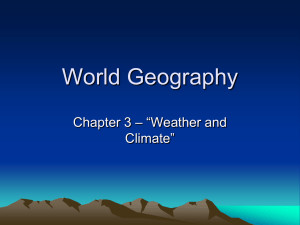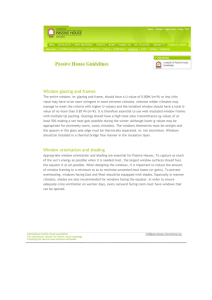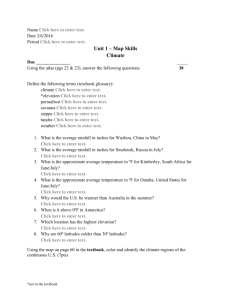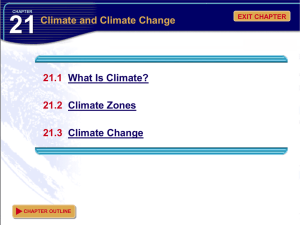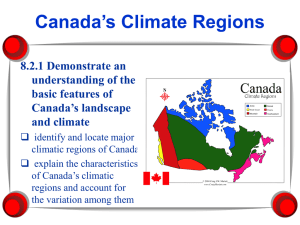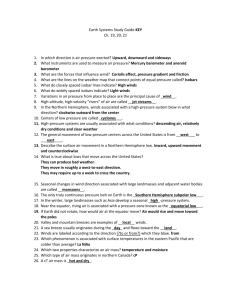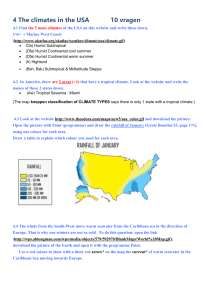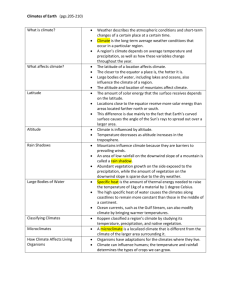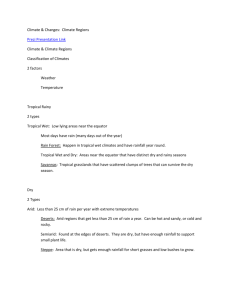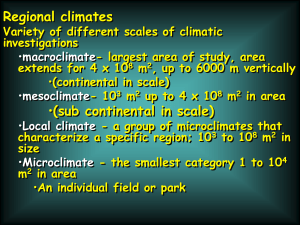Geology Chapter 21 Climate
advertisement
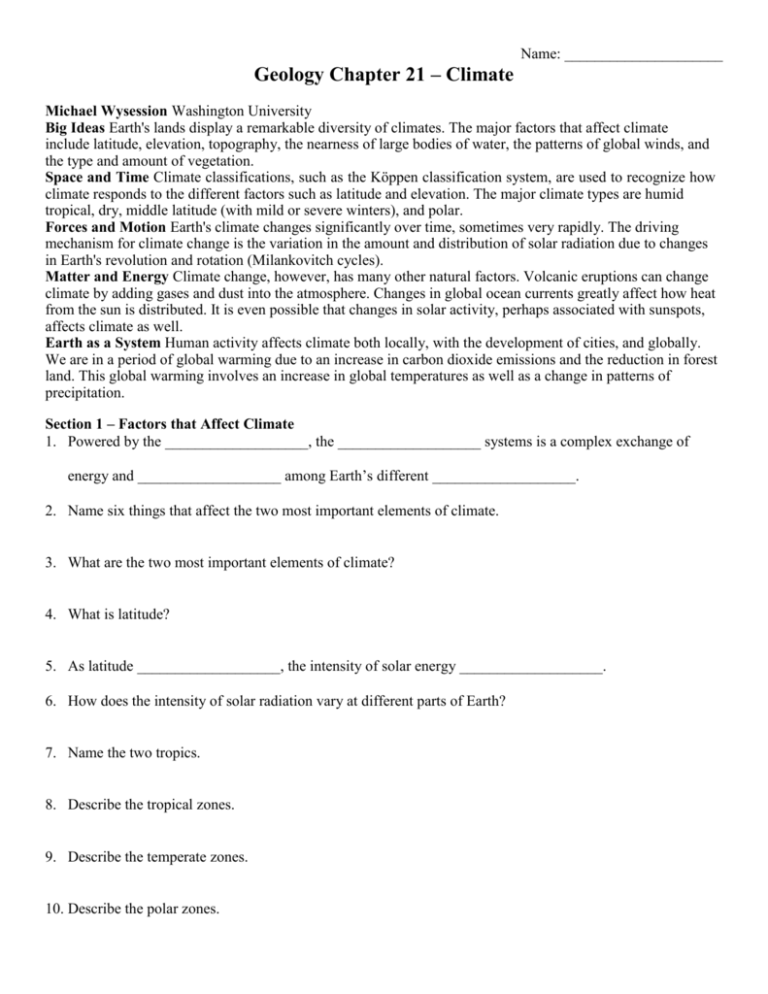
Name: _____________________ Geology Chapter 21 – Climate Michael Wysession Washington University Big Ideas Earth's lands display a remarkable diversity of climates. The major factors that affect climate include latitude, elevation, topography, the nearness of large bodies of water, the patterns of global winds, and the type and amount of vegetation. Space and Time Climate classifications, such as the Köppen classification system, are used to recognize how climate responds to the different factors such as latitude and elevation. The major climate types are humid tropical, dry, middle latitude (with mild or severe winters), and polar. Forces and Motion Earth's climate changes significantly over time, sometimes very rapidly. The driving mechanism for climate change is the variation in the amount and distribution of solar radiation due to changes in Earth's revolution and rotation (Milankovitch cycles). Matter and Energy Climate change, however, has many other natural factors. Volcanic eruptions can change climate by adding gases and dust into the atmosphere. Changes in global ocean currents greatly affect how heat from the sun is distributed. It is even possible that changes in solar activity, perhaps associated with sunspots, affects climate as well. Earth as a System Human activity affects climate both locally, with the development of cities, and globally. We are in a period of global warming due to an increase in carbon dioxide emissions and the reduction in forest land. This global warming involves an increase in global temperatures as well as a change in patterns of precipitation. Section 1 – Factors that Affect Climate 1. Powered by the ___________________, the ___________________ systems is a complex exchange of energy and ___________________ among Earth’s different ___________________. 2. Name six things that affect the two most important elements of climate. 3. What are the two most important elements of climate? 4. What is latitude? 5. As latitude ___________________, the intensity of solar energy ___________________. 6. How does the intensity of solar radiation vary at different parts of Earth? 7. Name the two tropics. 8. Describe the tropical zones. 9. Describe the temperate zones. 10. Describe the polar zones. 11. What is elevation? 12. The ___________________ the elevation is, the ___________________ the climate. 13. Topographic features such as ___________________ play an important role in the amount of ___________________ that falls over an area. 14. Compare the windward and leeward sides of mountains in terms of precipitation. 15. What effect do large water bodies of water such as lakes and oceans have? 16. Why do global winds influence climate? 17. Name two ways that vegetation can affect climate in an area. 18. How do plants affect temperature? 19. How do plants influence precipitation? Section 2 – World Climates 20. The ___________________ climate classification system uses mean ___________________ and ___________________ values of ___________________ and ___________________ to classify climates. 21. List the five principal groups of the Köppen system. 22. Describe tropical climates. 23. Name the two types of humid tropical climates. 24. Describe wet tropical climates and give an example. 25. Describe tropical wet and dry climates and give an example. 26. Describe humid mid-latitude climates. 27. Describe humid subtropical climates and give an example. 28. Describe marine west coast climates and give an example. 29. Describe dry-summer subtropical climates and give an example. 30. Compare the two types of humid mid-latitude climates with severe winters. 31. Describe a dry climate and give an example. 32. Describe polar climates and give an example. 33. Describe highland climates. Section 3 – Climate Changes 34. Identify four natural processes that can result in climate changes. 35. The presence of ___________________ (volcanic ash, dust, and sulfur-based aerosols) in the air ___________________ the amount of ___________________ radiation that is reflected back into space. The causes Earth’s lower atmosphere to ___________________. 36. How do the ocean currents affect climate? 37. What does the formation of sunspots appear to correspond with? 38. Is the affect of the sun a long-term or a short-term affect? 39. Is the affect of Earth’s motions a long-term or a short-term change in climate? 40. How does tectonic plate movements affect climate? 41. Changes in the ___________________ of Earth’s ___________________ and the ___________________ of Earth on its ___________________ are other Earth motions that affect global climates. 42. Define the greenhouse effect. 43. Name the two major gases involved in the greenhouse effect. 44. Why is the greenhouse effect important to Earth? 45. How have humans impacted the greenhouse effect? 46. What is global warming? 47. What do warmer surface temperatures do? 48. What will an increase in evaporation rate do? 49. What will an increase of water vapor in the atmosphere do? 50. What will a temperature increase cause? 51. Ice ___________________ more incoming ___________________ radiation than ___________________ water does. 52. List two things that the melting of ice will cause. 53. Scientists also expect that ___________________ patterns will change as a result of the projected _______________________________.
